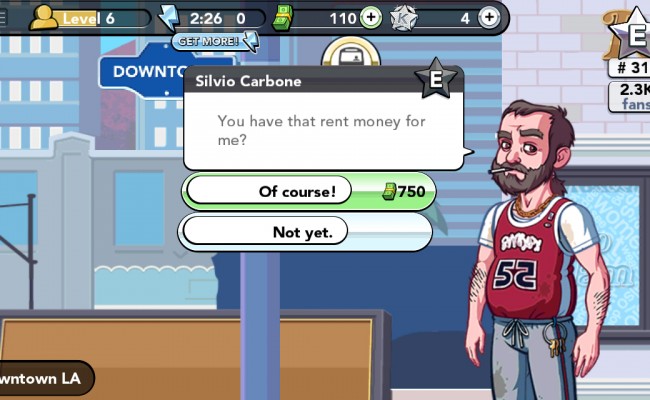My introduction to Kim Kardashian: Hollywood was through an overheard conversation. Two friends who would be the first to tell you that they are not in any way ‘gamers’ were discussing their custom-made celebrity avatars. They were sharing networking and dating tips, and reminiscing about some of the game’s sharper jokes. I was reminded of sitting in Heathrow Airport earlier in the year and seeing an older man and a young girl playing Flappy Bird side-by-side on their devices, sharing tips and strategies.
Now, for the second time in one year, I’d seen people completely removed from the narcissistic enclosure of ‘gamer culture’ experiencing and discussing a video game in a mundane, everyday way. Just as you would a film; just as you would a pop song.
At first glance, Flappy Bird and Hollywood are about as different as one could imagine. Flappy Bird is the creation of a single bedroom coder from Vietnam: a brutally difficult game that is completely free to play (making its money from the obnoxious ads that pop onto the screen every few minutes). Hollywood, on the other hand, is the work of a sizeable Californian mobile games publisher. It’s incredibly straightforward, and offers the player opportunities to spend money at every moment. Yet, it is in the way each game, at the same time, manages to raise the hackles of (or, at best, be completely ignored by) a core video game culture while attracting a much broader playing base that the two games find their overlap. In their own ways, each game is open and accessible in ways core video games are only every closed and elitist.
In Hollywood, itself a rather transparent redesign of the developer’s earlier Stardom: Hollywood, the player begins life as a clerk at a clothes store in downtown LA. Moments after closing for the night, fate bumps them into Kim Kardashian herself and, after helping her with a fashion emergency, they become best of friends. From here, Kardashian becomes the player’s personal guide, putting them in touch with agents, photographers, real estate agents, and dates as the player becomes increasingly famous, attracting more and more followers.
It’s in the game’s attention to polish and smart writing that it finds its success. More than the lazy cash-in a game that shares the name of a celebrity could be, Hollywood is beautifully animated and sharply written. Each environment, presented from a simple, side-on perspective, is bursting with life and depth. Cars rush by the foreground while silhouettes of rich people sip wine in the background. Every room of every building is vibrant and near bursting with life. The interface, too, feels near bursting, yet never cluttered. The amount of information squeezed onto the edges of the screen, and the ease with which it can be navigated demonstrates a maturity in smartphone game design.
The writing, meanwhile, is fresh and self-aware. Jokes are constantly being made at the expense of the celebrity culture the game depicts, showing an awareness of the game’s own superficial content. A personal favourite was when, after an incident with a low-level celebrity in a bar, he tried to begin rumours about a conspiracy between myself and Kardashian on the game’s in-game Twitter feed, hashtagging his tweet ‘#illuminati #obamacare’. It’s funny, cool, flippant, and far more topical than any blockbuster video game could hope to be.
It also manages to be more progressive than most video games, offering the player a choice of genders at the start of the game, and the choice during the game to date men or women, never forcing the player to commit to one or the other. Kardashian, musing on who she will set you up with on a date, assumes your heterosexuality, but the game allows you to correct her, at once casually dealing with both heteronormativity and homosexuality in the space of a couple of seconds. Which is not, of course, to say this game about becoming famous is a bastion of progressive politics, but more that it smoothly and coolly deals with themes and identities that blockbuster games struggle to even acknowledge.
Its slick presentation makes it easy to see why Hollywood has become such a popular success, one that is predicted to make Kim Kardashian a lot of money. But what is most fascinating about Hollywood, for me, is the inside perspective on how celebrity culture sees itself. There is the constant presence of the celebrity ladder, ranking people purely by how many fans they have. There is the weird disposability of money, where ducking over to Miami is as easy as ducking over to Beverly Hills. And most of all, as Gita Jackson has discussed, there is the realisation of just how much work goes into becoming someone like Kim Kardashian, who is often depicted as being famous for doing ‘nothing’. There is always something that needs to be done, somewhere you need to be seen, and the presence of the game always right there in your pocket, on your phone, makes those engagements feel so much more pressing.
Yet despite everything the game does so well, that a celebrity like Kim Kardashian who is famous for ‘no reason’ would dare to even show her face on a video game frustrates many core gamers to no end. Writing at Daily Dot, Samantha Allen has already done a terrific job of highlighting the ingrained sexism at the heart of much of the criticism levelled at Kardashian, but in the case of Hollywood, it goes even deeper, connecting to a much broader issue of casual, mobile, and free-to-play games being simultaneously feminised and marginalised.
‘Core’ video games have historically been the domain of those privileged enough (by gender, race, class and/or age) to commit both the time and the money to powerful, dedicated gaming machines, and with games that take dozens of hours to complete. They are shot through with oft-repeated themes of masculinist militarism, and engagements of mastery and challenge that perpetuate and reinforce each other. The casual games of smartphones and social media, meanwhile, have none of these hurdles, playing on platforms and devices people already own for other purposes. They are designed to be accessible, to be played on a flexible timeframe (five minutes on the train in the morning, in front of the television at night), to be played and enjoyed by a much more diverse audience than core games with their massive dedications of time and money.
While casual games are no less commercially produced than core games, then, they are able to speak to an audience far more diverse than core games. However, because core games have been the ‘core’ for so long, they have come to stand for the canon of what a good video game should be, while any game that falls beyond this narrow form is sidelined. Make the argument that video games should represent women better because women make up half the players of video games (a proven fact), you will inevitably encounter the response that those statistics are skewed because most women only play casual games, so that doesn’t count.
It’s a two-pronged rhetorical attack that doesn’t just deny that a broader audience engages with video games, but that dismisses the games those very audiences are, indeed, playing. Flappy Bird was a victim of this, with game journalists and players alike dismissing its supposedly derivative design and supposedly plagiarised assets, even as countless others found an immediately accessible and pleasurable game. And now Hollywood, with the double-dose of sexism through a woman celebrity and casual mobile game design, is receiving its own dose of scorn as countless others, again, find an immediately accessible and pleasurable game.
None of this is to say that Hollywood is above criticism. It buys into, glorifies, and absolves a materialist celebrity culture even as it laughs at itself. Everyone is shiny, slim, and rich. Class is obliterated in this dreamland version of American. Then there are the micro-transactions. As with most free-to-play casual games, Hollywood is free to download and start playing, but all actions require the use of ‘energy’, which quickly runs out and needs recharging. You can recharge it by spending money, or waiting until you keep playing. Energy mechanics are not fundamentally evil (Zoya Street recently released a book critically analysing the energy mechanic as a design decision), but they are easily exploited, with the real cost of more energy often hidden behind fake currencies, and poker-machine-styled strategies used to hook players in for ‘just one more’ purchase. Hollywood is more transparent than most in this regard, but its prices for more energy are laughably overpriced.
But these are not the criticisms many people are making. Instead, they scoff that such a game would exist in the first place, or that people would be so stupid as to play it, disregarding the game’s many successes in both art and design. In mechanistic arguments that reduce the game to pure form, I’ve seen some dismiss it as a mere ‘reskin’ of the publisher’s previous game, claiming that it would be the same game without the blemish of Kardashian’s endorsement. It is an issue I don’t recall arising when Tony Hawk sold his name and likeness to Tony Hawk Pro Skater. But when a woman celebrity endorses a video game that will mostly appeal to young women, the fact a celebrity’s name is attached to the game becomes an unforgivable offence.
Yet, this celebrity-endorsed free-to-play mobile game will probably, alongside Flappy Bird, go down as one of 2014’s most culturally relevant (never mind financially successful) video games. Hollywood is no more or less an industrial product than the blockbuster games that line the shelves at EB games, but it has tapped into a popular zeitgeist that the large studios – still trying to explain why their games don’t include women – can’t hope to speak to anytime soon, and it’s done it in style.






